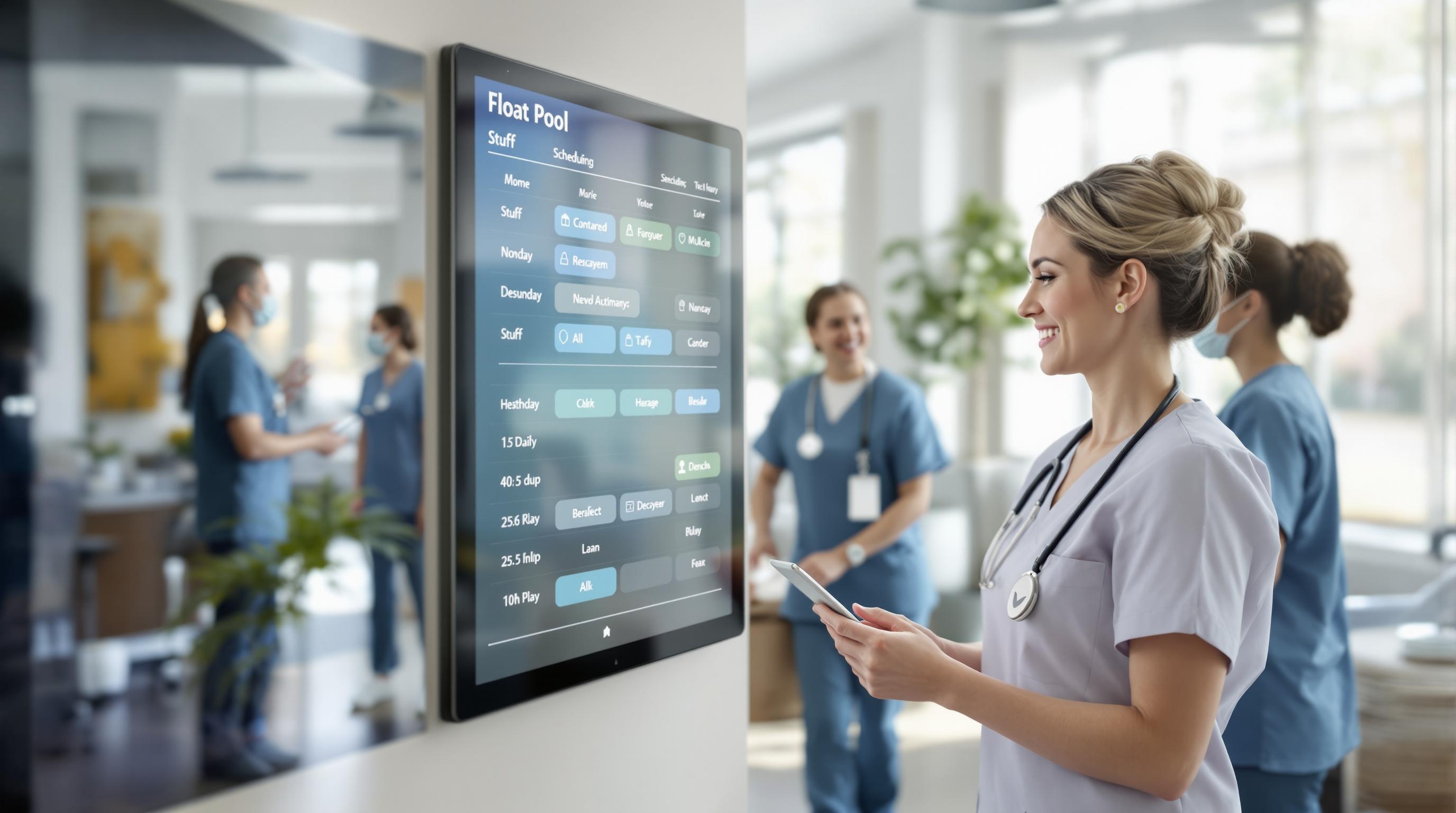Automated Shift Assignments: Streamlining Staffing in Skilled Nursing
Discover how automated shift assignments boost efficiency, reduce burnout, and improve resident care in skilled nursing facilities.
Quick Navigation
- 1. Introduction
- 2. Current Challenges in Automated Shift Assignments
- 3. How Sparkco AI Transforms Automated Shift Assignments
- 4. Measurable Benefits and ROI
- 5. Implementation Best Practices
- 6. Real-World Examples
- 7. The Future of Automated Shift Assignments
- 8. Conclusion & Call to Action
1. Introduction
Did you know that nearly one in four U.S. nursing homes struggles with chronic staffing shortages each month? According to recent industry reports, the challenge of maintaining adequate nurse coverage in skilled nursing facilities (SNFs) is reaching a critical point—directly impacting both staff satisfaction and resident care. As healthcare workforce shortages intensify and patient needs become more complex, the traditional approach to shift scheduling—often manual, time-consuming, and prone to errors—is proving unsustainable.
For SNF administrators, building a reliable schedule isn’t just about filling slots; it’s a complex balancing act that must account for regulatory compliance, fluctuating census, staff skill sets, and individual preferences. When schedules go awry, the consequences ripple throughout the facility: increased turnover, burnout, compliance risks, and, most seriously, compromised quality of care for vulnerable residents.
Enter automated shift assignments: a technology-driven solution that is reshaping the future of healthcare staffing. Leveraging the power of automation and machine learning, these systems promise not only to streamline scheduling but also to optimize nurse-patient assignments based on real-world data and evolving facility needs.
In this article, we’ll explore how automated shift assignment tools are transforming the scheduling landscape in skilled nursing facilities. We’ll examine the pressing challenges facing SNF administrators, highlight the tangible benefits automation brings to both staff and residents, and provide actionable insights for facilities looking to implement or upgrade their scheduling solutions. Whether you’re a nursing leader, HR professional, or healthcare executive, read on to discover how embracing automation can drive better outcomes for your facility and those you care for.
2. Current Challenges in Automated Shift Assignments
Automated shift assignment systems promise to streamline scheduling and relieve administrative burdens for healthcare facilities. However, their implementation often introduces a unique set of challenges that can impact operational efficiency, regulatory compliance, and ultimately, patient care outcomes. Below are some of the most pressing pain points experienced by healthcare organizations using automated shift assignment technologies.
-
Inadequate Customization for Complex Staffing Needs
Many automated systems lack the flexibility to manage the intricate requirements of healthcare teams, such as varying certifications, seniority, and staff preferences. According to a 2021 study in the Journal of Nursing Management, 67% of nurse managers reported that automated scheduling tools often failed to account for specialized skill sets and patient acuity, leading to mismatched assignments and increased stress on staff. -
Data Integration Issues with Existing Systems
Automated shift assignment tools frequently struggle to integrate seamlessly with legacy electronic health records (EHRs) and payroll software. A 2022 Healthcare IT News report found that 55% of facilities encountered data synchronization problems, causing errors in shift records and payroll, and complicating compliance with labor laws. -
Limited Accommodation of Last-Minute Changes
Healthcare is dynamic, and last-minute callouts or surges in patient census demand rapid schedule adjustments. Automated systems may lack the agility to process these changes efficiently, leading to understaffing or overstaffing. The Advisory Board notes that 48% of hospitals report persistent scheduling gaps due to system rigidity. -
Staff Dissatisfaction and Burnout
While automation is meant to ease workloads, impersonal algorithms may ignore staff preferences, work-life balance, or historical scheduling patterns. A 2020 survey published in BMC Nursing found that 60% of nurses felt less engaged and more likely to experience burnout when shift assignments did not reflect their input. -
Compliance Risks with Labor Laws and Accreditation Standards
Automated systems that are not regularly updated to reflect regulatory changes can inadvertently schedule staff in violation of mandatory rest periods or maximum working hours. This not only exposes facilities to legal penalties but can also compromise patient safety. According to the Joint Commission, improper scheduling contributed to 17% of compliance citations in 2022. -
Inaccurate Forecasting and Resource Allocation
Automated tools often rely on historical data, which may not accurately predict sudden changes in patient volume or acuity. This can lead to inadequate staffing levels, affecting both operational budgets and the quality of patient care. Research from the American Hospital Association indicates that over 50% of hospitals faced critical staffing shortages in 2023, despite using automated scheduling systems.
These challenges highlight the need for healthcare facilities to continuously evaluate and refine their automated shift assignment processes. Without careful consideration of operational realities, regulatory demands, and staff well-being, the promise of automation may fall short—potentially affecting compliance and compromising patient care quality.
3. How Sparkco AI Transforms Automated Shift Assignments
How Sparkco AI Tackles Automated Shift Assignment Challenges
Automated shift assignment is a persistent challenge for skilled nursing facilities and healthcare organizations. Traditional scheduling methods—often reliant on spreadsheets or paper rosters—are time-consuming, error-prone, and inflexible, leading to staff burnout, gaps in coverage, and compliance risks. Sparkco AI transforms this process with intelligent automation and advanced scheduling algorithms, addressing these challenges head-on. Here’s how Sparkco AI delivers seamless, efficient, and reliable shift assignments:
-
1. Intelligent Staff Matching
Sparkco AI leverages advanced algorithms to assign shifts based on each employee’s qualifications, certifications, availability, and past performance. The system instantly cross-references licensure, skill sets, and required credentials—ensuring that only properly qualified staff are scheduled for the right shifts. This minimizes compliance risks and maintains high standards of patient care.
-
2. Automated Conflict Resolution
Manual scheduling often results in double-bookings or overlooked time-off requests. Sparkco AI’s real-time conflict detection automatically spots and resolves overlapping shifts, overtime risk, and vacation requests. By doing so, it reduces administrative headaches and enhances staff satisfaction by honoring their preferences whenever possible.
-
3. Dynamic Shift Optimization
Sparkco AI continually analyzes staffing patterns, census data, and workload forecasts to adjust shift assignments dynamically. Whether census surges or drops, the platform recalibrates schedules to match real-time demand, preventing overstaffing and costly agency usage while maintaining optimal care levels.
-
4. Employee Self-Service Portal
Empowering frontline staff is key to engagement and retention. Sparkco AI offers an intuitive self-service portal where caregivers can swap shifts, request time off, and set availability—all from their mobile devices. The AI engine automatically incorporates these inputs into the master schedule, reducing the need for manual adjustments and fostering a collaborative work environment.
-
5. Compliance and Audit Readiness
Regulatory compliance is non-negotiable in healthcare. Sparkco AI tracks all scheduling decisions, shift changes, and credential validations, generating comprehensive audit trails. This feature makes it easy for administrators to demonstrate compliance with labor laws and staffing regulations, reducing legal risk and administrative burden.
-
6. Seamless System Integration
Sparkco AI is designed for interoperability. It integrates effortlessly with existing HR, payroll, and clinical systems through secure APIs. This ensures data consistency across platforms, eliminates redundant data entry, and enables holistic workforce management—from scheduling to payroll processing.
By combining intelligent automation with a user-friendly interface and robust integration capabilities, Sparkco AI eliminates the inefficiencies and frustrations of manual shift assignments. The result is a smarter, more flexible, and highly reliable scheduling process—optimizing coverage, enhancing staff engagement, and supporting the delivery of exceptional patient care.
4. Measurable Benefits and ROI
Automated shift assignments are rapidly transforming workforce management in healthcare settings, particularly in skilled nursing facilities. By replacing manual scheduling with intelligent, data-driven automation, organizations are unlocking significant returns on investment (ROI) and seeing measurable improvements across key operational metrics. Below, we examine the most impactful benefits and real-world data that highlight why automation is becoming the industry standard.
-
1. Time Savings: Up to 80% Reduction in Scheduling Effort
Manual shift scheduling typically requires hours of administrative labor each week. According to TATEEDA, automated rostering solutions can reduce the time spent on scheduling by up to 80%. For a facility that previously devoted 10 hours weekly to scheduling, this translates to saving 416 hours—or over 10 full workweeks—annually. -
2. Cost Reductions: 15-25% Decrease in Overtime Expenses
Overtime costs are a significant financial burden in healthcare. Automated shift assignments optimize staff allocation, decreasing unnecessary overtime. Many organizations report a 15-25% reduction in overtime expenses after implementing automated systems, directly improving the bottom line (TATEEDA). -
3. Compliance Improvements: 99% Adherence to Labor Laws
Compliance with labor regulations and union rules is critical. Automated systems ensure complex rules are consistently applied, with some facilities achieving 99% scheduling compliance—dramatically reducing the risk of costly violations and penalties. For more, see this study on nurse rostering. -
4. Reduced Scheduling Errors: Up to 90% Fewer Mistakes
Manual scheduling is prone to errors—double bookings, missed shifts, or non-compliance. Automated systems decrease errors by up to 90%, leading to fewer grievances, improved staff satisfaction, and better patient care (TATEEDA). -
5. Improved Staff Retention: 20% Lower Turnover Rates
Inefficient scheduling contributes to burnout and high turnover. Facilities using automated scheduling report up to 20% lower turnover rates, retaining experienced staff and reducing recruitment costs. -
6. Enhanced Productivity: 10-15% Increase in Clinical Hours
Automation enables more optimal shift distribution, increasing productive clinical hours by 10-15%. This means more staff time devoted to resident care rather than administrative tasks. -
7. Better Fatigue Management: Up to 30% Reduction in Fatigue-Related Incidents
Automated systems account for rest periods and shift rotations, helping reduce fatigue-related errors. Studies show up to a 30% decrease in fatigue-related incidents among staff (source). -
8. Increased Employee Satisfaction: 2x Higher Engagement Scores
When staff have more input and predictability in their schedules, job satisfaction rises. Organizations using automated scheduling often report engagement scores twice as high as those relying on manual processes.
In summary, the adoption of automated shift assignments generates substantial, measurable ROI for skilled nursing and healthcare facilities. These tools not only drive operational efficiency and cost savings, but also foster a safer, more compliant, and more satisfying work environment for staff. For further data and real-world examples, visit the resources at TATEEDA and review research on nurse rostering practices.
5. Implementation Best Practices
Adopting automated shift assignment technology is a proactive way for skilled nursing facilities to address new CMS minimum staffing standards and streamline staff scheduling. However, a thoughtful, structured implementation approach is essential to maximize ROI and ensure regulatory compliance. Here are eight actionable steps for successful deployment, each with practical tips and pitfalls to avoid:
-
Conduct a Comprehensive Facility Assessment
Review your current staffing patterns, workflows, and unique care needs. Ensure alignment with CMS minimum staffing standards and facility assessment requirements.
Tip: Involve both clinical and administrative leaders in this assessment.
Pitfall: Skipping input from direct care staff can result in overlooking daily operational challenges.
-
Select the Right Automated Solution
Evaluate vendors for compliance with CMS rules, integration capabilities, and user-friendliness. Request demos and check references from similar facilities.
Tip: Prioritize platforms that offer customizable rules to accommodate special resident needs and shift preferences.
Pitfall: Choosing based solely on price may lead to inadequate functionality or poor support.
-
Develop a Change Management Plan
Communicate the benefits and process changes to all stakeholders early. Address concerns about job security and fairness in shift assignments.
Tip: Hold town hall meetings and provide clear, honest messaging about the goals of automation.
Pitfall: Failing to address staff anxieties can lead to resistance and low adoption.
-
Customize System Parameters
Configure the system to reflect your facility's policies, union requirements, and CMS regulations (e.g., minimum RN and aide hours per resident day).
Tip: Test different scenarios to ensure the system accommodates both regular and contingency staffing needs.
Pitfall: Overlooking regulatory requirements can result in non-compliance during audits.
-
Train Staff Thoroughly
Provide comprehensive, role-specific training for schedulers, managers, and frontline staff. Offer hands-on practice and ongoing support.
Tip: Develop quick-reference guides and designate “super users” for peer assistance.
Pitfall: Insufficient training can lead to scheduling errors and frustration.
-
Pilot the System Before Full Rollout
Start with a single unit or shift to identify potential issues and gather feedback.
Tip: Use the pilot phase to fine-tune system settings and address workflow gaps.
Pitfall: Launching facility-wide without a pilot increases the risk of widespread disruption.
-
Monitor, Evaluate, and Adjust
Track key metrics such as shift coverage, overtime, and staff satisfaction. Solicit regular feedback and be prepared to make iterative improvements.
Tip: Schedule periodic reviews to ensure continued compliance with










